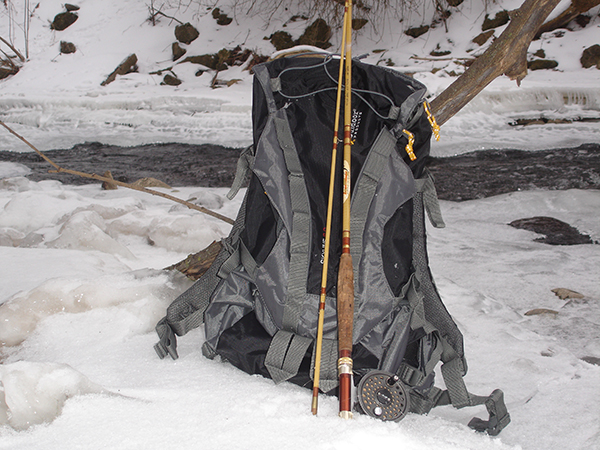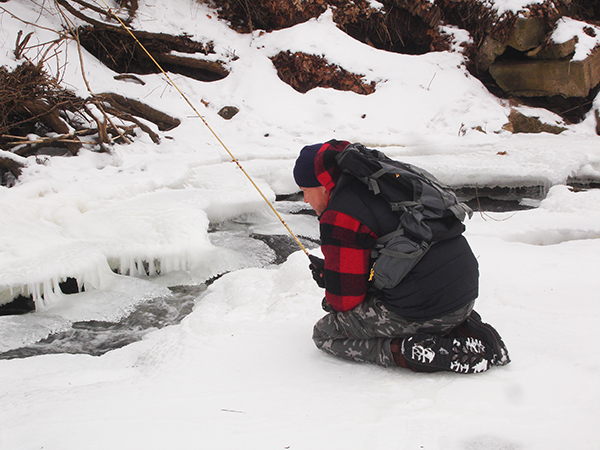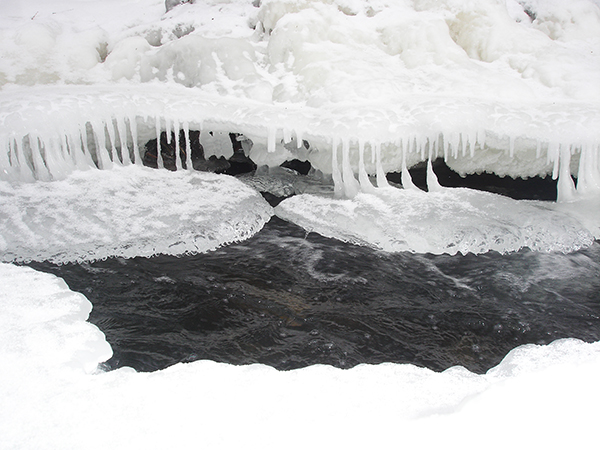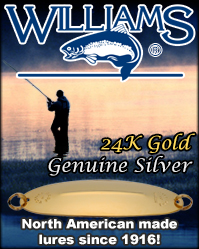Fencerows: Packing it in on the Waters of Winter
By John Luthens
I was forty feet above Sauk Creek, on the fringes of Port Washington, Wisconsin. It was shaping up to be a perfect, January stalk. The rocky banks were snow covered and the water swirled through ice flows below. The only tracks winding to the water below were made by deer and coyotes. I was working above a deep pool that I hoped might hold a fish. I was daydreaming that I was steelhead fishing in the wilds of Alaska. That’s when all hell broke loose.
The snow gave way beneath my feet in an avalanche slide, I went down on my stomach, tried to grab a tangled vine, missed, and dropped to the next level of rock below to continue my descent. The water finally stopped my plunge. It was 15 degrees Fahrenheit in the air. The water was around 40. I was nearly up to my waist and shipping water fast. I don’t know if it was a rock or a tree that I grabbed onto to pull myself onto the bank. I just know that I popped out in a hurry.
I was bundled up good and had avoided taking any scrape damage; No bones broken and my fly rod still in one piece. My feet were wet, I had yet to wet a line, and my gloved fingers were hardening into icicles before my eyes. Tying on a tippet or a fly looked to be a drawn out and painful process.
There was the low hum of traffic in the distance and my truck was within a relatively short distance. I could admit defeat and crawl home easy enough, but that would be missing the point. Chasing winter steelhead is a challenge of man versus nature. Unforeseen circumstances roll across your path as quickly as a snow squall. But with proper preparation, these challenges don’t have to stand in the way of a thrashing, winter steelhead on the end of a line.
My shoulder pack had avoided getting baptized. I know that is water proof because I’ve had multiple occasions to test it out on fishing dunks in the height of summer – not on purpose, mind you – but I’m not sure if it is ice-proof, and I was glad I didn’t have to find out. Without that pack and its contents, I really had no business fishing on any river in the middle of winter. I took a deep breath, found a handy log, and took inventory:
Dry, wool socks, a great start. I carry several extra pair. Wet toes in summer can slosh themselves warm in the bottom of waders or hip boots. Winter in Wisconsin is not fond of this method. It would much rather turn your toes into a painful array of blue and purple. They eventually turn black and fall off, which does stop the pain, but which also makes you look like a freak if you want to go barefoot in summer.

A good pack is an essential part of winter river fishing.
There is an assortment of gloves, with varying thresholds from brisk autumn to arctic invincibility. My go-to pair has a thermal shell with the fingertips cut out. I wear cotton gloves underneath to be able to play out line and work a fly reel. Inevitably, when my fingers get wet, I switch out to a new pair of cotton gloves underneath. I keep a standby pair of mittens handy for warming up between invigorating casting sessions.

John Luthens tries for a winter steelhead in an icy pool.
I dig out disposable hand warmers when I need to change flies or tie on a new leader or a new section of tippet. I have enough trouble remembering all the joining knots, moreover, being able to tie them all correctly. On a breezy summer’s day, if you’ve ever wrapped a wind knot in your line, you understand the patience required to undo the snarls of nature. Ice knots, along with iced-over rod guides, make wind knots look like child’s play. Hand warmers eliminate my dependence on gloves when I need to act with surgical precision. They also minimize the foul language that I’ve been known to yellow the pristine snow of winter with.
I have a handy, water-bottle holder within easy reach on one side of the pack. It doubles nicely as a thermos holder in the winter. Hot coffee is a luxury, but I figure if I’m willing to carry it in, I deserve it. I do carry an insulated water bottle in the pack itself. Blood vessels contract in cold weather to conserve heat, and the last thing I need while navigating an icy river is a dehydration cramp.
My camera is also stowed in my pack. When I really start to feel the cold creep into my bones, I camouflage my rod against a tree, grab the camera, and warm up by hiking along on a river bank photo shoot. A river in winter produces the most fantastic natural ice sculpting in the world. The patient power of nature will put the best architect to shame. And if I’ve done a good job of hiding my rod behind a really good, nondescript tree, I get doubly warm trying to find it again when I return from my nature hike.

Sculptures in the ice.
If I do find myself on remote river section, and if really get in over my head, I know that I might need to start a fire rather quickly. I’m not a real survivor-man when it comes to starting fires. I’d carry a flame thrower and can of lighter fluid if I thought it was practical. As an alternative, I carry a box of waterproof matches and a sealed film container of cotton balls soaked in lighter fluid. The cotton balls make good tinder. Given a few twigs and handful of matches, I can usually manage to eek out something resembling a flame.
I bring my cell phone sealed in a plastic bag. It is one of the only things I don’t keep in the pack. It would get mixed in with extra reels, fly boxes, sandwiches, cookies, cool-looking rocks, dead squirrel’s tails, or anything else that strikes my fancy and finds its way in there.
In all seriousness, I keep my phone where I can reach it in a hurry. Wisconsin is filled with the kinds of real-life adventure that many other parts of the country can only read about. But mixed with ice and water, Wisconsin winter is a cocktail that simply doesn’t fool around. As I found out on Sauk Creek, the line between a winter adventure and a near-tragedy can be crossed in a single step. Thankfully, with a little preparation and a good pack, it turned out to be just another beautiful winter day on the water.
John Luthens is a freelance writer from Grafton, Wisconsin. His first novel, Taconite Creek, is available on Amazon or at www.cablepublishing.com or by contacting the author at Luthens@hotmail.com












